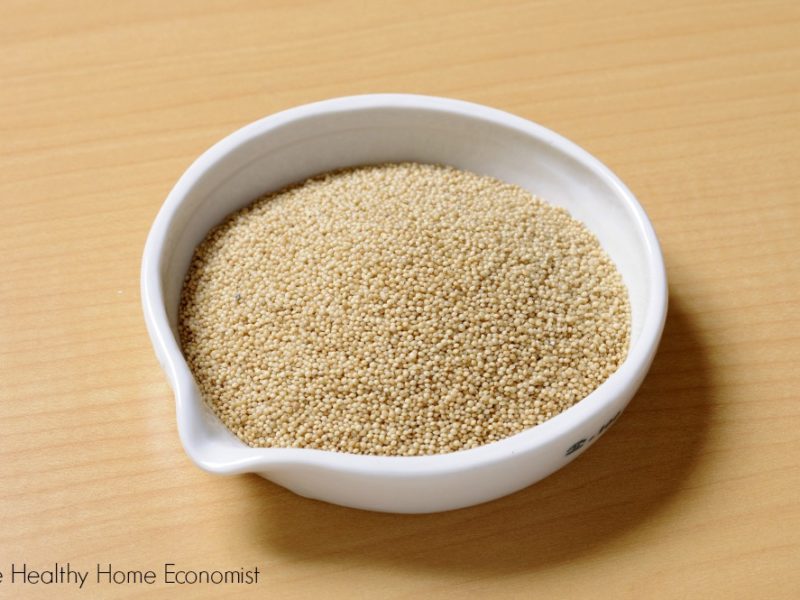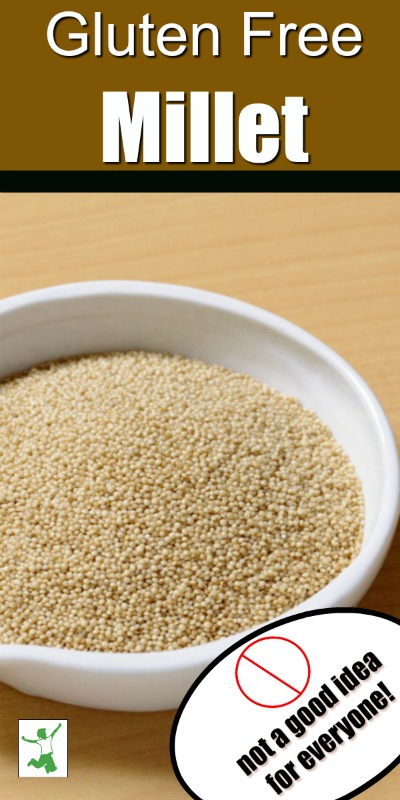Examination of why millet should optimally be eaten in moderation as a gluten-free whole grain in order to avoid disrupting hormone health.

Gluten allergies are clearly on the increase in our modern society. It seems like practically every other person I know these days has some sort of digestive issue that avoiding gluten would probably improve.
At the top of the list of gluten-containing foods is wheat. It is the indisputable, primary staple of the Western diet. Wheat is also the very foundation of the controversial USDA Food Pyramid.
Given how important bread and other wheat-based carbohydrates are to our society’s basic food requirements, it’s no wonder that folks seek a quick and easy substitute for wheat bread and wheat-based snacks when a gluten allergy or Celiac disease has been diagnosed.
Millet: Ancient Gluten-free Whole Grain
Enter millet. This ancient grain was cultivated in East Asia as far back as 10,000 years ago, according to archaeologists. Surprisingly, the cultivation of millet in prehistoric times was more prevalent than even rice, particularly in what is now China and the Korean peninsula.
Millet’s resistance to drought is perhaps the reason for its popularity in ancient times and its spread to Europe by 5000 B.C.
Despite the 5000 years cultivating this whole grain as a staple food, millet porridge is considered a traditional food in Russia as well as China. Use of millet is also widespread in Africa, like gluten-free teff, likely due to the drought-prone climate.
Millet Bread: Logical Substitute for Wheat
The protein structure of millet is quite similar to wheat. The one glaring exception is that millet is a gluten-free grain. Wheat contains copious amounts of this hard to digest plant protein.
When plain millet flour is used for baking bread (as opposed to homemade gluten-free flour or a healthy gluten-free flour mix from the store), the resulting loaf is light, white, and quite similar in texture to wheat bread. As a result, people who wish to avoid gluten tend to immediately gravitate to millet bread as the most logical and palatable substitute.
Millet bread is extremely popular in health food stores. Sami’s Bakery and Deland Bakery are two local bakeries that sell an absolute ton of millet bread to these stores around my local metro area.
I recently corresponded with a person up the East Coast of the USA who was consuming a lot of the millet/flax chips as an alternative to wheat-based snacks and had no idea of the potential health risks from consuming so much millet.
It was this discussion that led me to write this blog and warn folks about the dangers of consuming too much millet!
Potent Goitrogens
While millet does not contain gluten, it does contain goitrogens. These are substances that suppress thyroid activity and can lead to goiter. This condition involves enlargement of this very important gland which resides in the throat. Low iodine intake can also lead to goiter for those who rely on millet as a staple according to the Journal of Endocrinology and Metabolism.
Hypothyroidism is a serious and sometimes debilitating condition. It accompanies a weak or enlarged thyroid such as what occurs with goiter. Depression, difficulty losing weight, loss of hair, cold hands/feet, and fatigue are common hypothyroid symptoms. By some estimates, hypothyroidism is at epidemic proportions in Western society. (1)
Goitrogens in foods that contain them are usually reduced by cooking such as cruciferous vegetables like broccoli. However, cooking actually increases the goitrogenic effect of millet! Incidentally, the same effect occurs when fermenting soy.
Therefore, when folks begin eating large amounts of millet bread with a wholesale switch over from wheat, the thyroid suppressing effects of this simple dietary change can be profound. Injuring the thyroid can have a cascade effect on other glands as well. For example, those suffering from adrenal fatigue many times have thyroid issues as well.
Moderation is Critical
Protect your thyroid at all costs! It is a real challenge to unwind the effects of hypothyroidism once this vital gland is weakened or enlarged. Don’t take any chances with your thyroid health by consuming large amounts of millet bread or millet based snacks.
If gluten and/or wheat is a problem, then simply reduce bread consumption. Alternatively, use another grain that is both gluten-free and non-goitrogenic such as rice, oats or teff. Be sure to get quality, though, as rice is frequently high in arsenic.
Alternatively, try using grain-like gluten-free foods such as highly nutritious buckwheat, amaranth, or the starchy tuber cassava. They are excellent for baking too!
Millet bread consumption is fine in moderation if your thyroid is healthy – just don’t overdo it!
Given how difficult it is in modern society to maintain thyroid and overall glandular health, taking a chance by eating a lot of millet bread is a risky proposition indeed.
Traditional peoples did not have the constant stresses and strains on their glands like modern people do.
For example, they did not have to contend with pollution of their food, water, air and overall environment.
Therefore, we must be overprotective of our thyroid health. This includes avoiding regular consumption of foods that might impair it in any way.

Millet Alternatives That Preserve Thyroid Function
If you have thyroid issues and need alternatives to millet, here is a list of the healthiest options to consider.
- Einkorn Benefits (contains “good gluten“)
- Teff Benefits
- Yuca Root Benefits
- Arrowroot Benefits
- Wild Rice Benefits
- Farro (great if only modern wheat is the problem)








Goitrogenic foods like cabbage/broccoli/kale need to be steamed or cooked ….then they are fine
thanks for this, i’ve started replacing rice with it.
According to people’s experience in the Hashimoto’s 411 group, you can try the goitrogenic food and see which one bothers you. It may not affect you. Everyone is different. Plus if you cook it or ferment it, it destroys most of the goitrogenic substance, except millet and soy. Dr. K also mentioned that it should not cause problem except if you a lot of it.
Good grief what am I going to eat then. So sad about that list above.
Firstly, I really appreciate your WAPF videos. I bought ‘Nourishing Traditions’ recently and the videos are a big help. Have a question though – a lot of the focus is on hypothyroidism, which is apparently more widespread, but how about HYPERthyroidism (which my mom has)? Does eating goitrogenic foods like bok choy and broccoli actually help in this case? Trying to find some answers. If anyone knows, please share. Thanks!
I have graves, I shod probably just start eating down that list.
Wich food are inflammatory?please i need to know i love cabbage
THANK YOU
Other goitrogenic foods:
Cassava and Cabbage both due to the foods containing thiocyanate[6]
Soybeans (and soybean products such as tofu, soybean oil, soy flour, soy lecithin)
Pine nuts
Peanuts
Millet
Strawberries
Pears
Peaches
Spinach
Bamboo shoots
Sweet Potatoes
Vegetables in the genus Brassica [7]
Bok choy
Broccoli
Broccolini (Asparations)
Brussels sprouts
Cabbage
Canola
Cauliflower
Chinese cabbage
Choy sum
Collard greens
Horseradish
Kai-lan (Chinese broccoli)
Kale
Kohlrabi
Mizuna
Mustard greens
Radishes
Rapeseed (yu choy)
Rapini
Rutabagas
Tatsoi
Turnips
Maybe I should just not eat.
Haha… After Becky’s list — which consists of everything I LOVE — I feel the same way. Defeat.
If a food makes you feel ill after eating then don’t eat it again.
good grief!
“don’t eat goitrogenic foods; don’t eat gluten containing foods, etc. etc.”
what an incredibly limited diet. i can’t imagine that it is healthy.
WHY are all these healthy foods now not-so healthy.
what is flipping left to eat???
Question: Are there any other gluten-free grains that would work better for the occasional treat? (Spelt is on my list of things to avoid.)